North Central New Mexico
North Central New Mexico is Georgia O'Keeffe country — the high desert with the amazing colors. This is a region of incredible scenic variety and fascinating cultural nuances, with two gorgeous mountain ranges separated by the valley of the Rio Grande. One of the world's great travel destinations, Santa Fe, serves as the southern gateway to the region and is famed for its beauty, culture, and art.
Cities
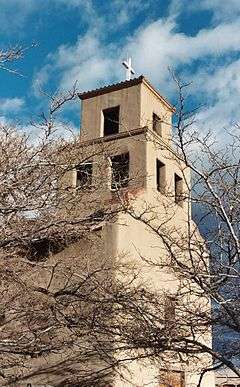
- 🌍 Abiquiu - Noted for its colorful scenery and its historical connection to Georgia O'Keeffe — nearby Ghost Ranch was a home to O'Keeffe and today serves as a retreat with a pair of small museums on-site and several hiking trails into the red-rock country that O'Keeffe's paintings made famous.
- 🌍 Angel Fire - A resort town in the mountains east of Taos that holds a popular ski resort in the winter and many outdoor activities in the summer, as well as a noted memorial to veterans of the Vietnam War.
- 🌍 Chama - Near the Colorado border on the northwestern corner of the region, this small town is locally famed for its scenic narrow-gauge railroad.
- 🌍 Chimayó - At the base of the Sangre de Cristo Mountains, this old Hispanic village is home to the Santuario de Chimayo, a centuries-old church reputed for miracles that is the focus of an annual pilgrimage every Easter.
- 🌍 Eagle Nest - A small resort town situated on the shores of pleasant Eagle Nest Lake, set at the bottom of a beautiful mountain valley east of Taos.
- 🌍 Española - The most prominent community between Santa Fe and Taos, Española has few tourist attractions but serves as a local commercial center and a useful staging point for trips around the region.
- 🌍 Los Alamos - The "Atomic City" where the first atomic bomb was created during WWII, Los Alamos is still the home of the Los Alamos National Laboratory and feels far removed from the rest of New Mexico. Visitors will find a museum devoted to atomic weapons and energy, attractions related to the history of the town, and pleasant mountain scenery.
- 🌍 Madrid - An old mining town in the high desert country south of Santa Fe, now home to a small but thriving art colony.
- 🌍 Pecos - Along I-25 east of Santa Fe, this small community serves as a gateway to the southernmost reaches of the Sangre de Cristo Mountains and is home to Pecos National Historic Park, which preserves the ruins of an abandoned Indian pueblo and Spanish mission.
- 🌍 Pojoaque - A small pueblo that primarily serves as a stopping point on the road between Santa Fe and Española.
- 🌍 Red River - A resort community nestled in a canyon in the Sangre de Cristo Mountains north of Taos that's home to a ski resort and draws a very Texan crowd.
- 🌍 Santa Fe - The capital and principal tourist destination of the state, with a wealth of attractions for visitors: several excellent art and history museums, lovely examples of local architecture, historic churches, many festivals, a vibrant performing arts community, numerous fine restaurants, and a smorgasbord of art galleries await.
- 🌍 Taos - A prominent community in the northern portion of the region and set between the steep Sangre de Cristo Mountains and the spectacular gorge of the Rio Grande, Taos is something of a smaller, more laid-back Santa Fe. The town and its surrounding communities are noted for a thriving art colony, the popular Taos Ski Valley resort, the iconic Taos Pueblo, and the area's general hippie vibe.
Other destinations
.jpg)
- 🌍 Bandelier National Monument - A large national monument near Los Alamos that preserves the remnants of a set of striking ancient cliff dwellings that were carved into the cliffs of a scenic canyon, as well as a scattering of other archaeological sites and a large wilderness of canyons and mesas.
- 🌍 Jemez Mountains - A major mountain range to the west of Santa Fe and the Española Valley, home to Los Alamos, Bandelier National Monument, and a smattering of scattered attractions as well as plenty of recreational opportunities.
- 🌍 Rio Grande del Norte National Monument - A BLM-administered national monument that covers a spectacular stretch of gorge along the Rio Grande west of Taos that's popular for hiking, sightseeing, and whitewater rafting.
- 🌍 Sangre de Cristo Mountains - The highest mountain range in the state, running west of Santa Fe, the Española Valley, and Taos, offering plenty in the way of outdoor recreation, including most of the state's ski resorts.
- 🌍 Valles Caldera National Preserve - A spectacular unit of the national parks system that preserves a scenic grassland within a vast volcanic caldera in the midst of the Jemez Mountains.
Understand
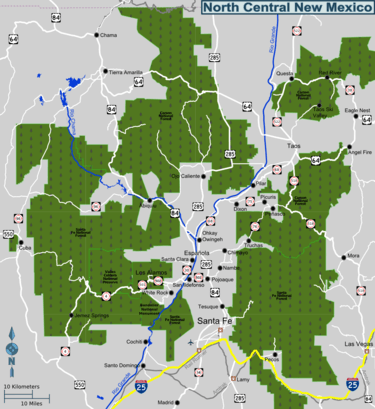
The term "North Central New Mexico" broadly applies to the region bounded on the:
- North, by the Colorado state line;
- East, by the Sangre de Cristo Mountains, southernmost range of the Rocky Mountains, and their foothills;
- South, by Santa Fe and environs -- larger Albuquerque is part of the Central region;
- West, by the Jemez Mountains and, north of Abiquiu, the mountainous country along the Rio Chama west of US 84.
History and culture
Humans have been present in the region for well over a thousand years, as evidenced by the presence of the remnants of Ancestral Puebloan settlements scattered throughout the Jemez Mountains and its foothills, the most famed of which are the cliff dwellings of Bandelier National Monument. The inhabitants of these settlements are generally believed to be the ancestors of today's Pueblo Indians, who primarily settled along the Rio Grande and its tributaries in New Mexico, where many of them still live to this day.
The first Europeans to arrive in the region were the Spanish, with the first European settlement west of the Mississippi established near present-day Española in 1598, shortly prior to the construction of a capitol city at Santa Fe. Tension grew between the Pueblo Indians and the Spanish, particularly as a result of the vicious treatment of the natives by Spanish missionaries, which resulted in the Puebloans revolting against the Spanish. Though the Spanish would reconquer the region, they returned more willing to grant the Puebloans land and rights, allowing the two cultures to live alongside each other. Despite the region's isolation at nearly the northernmost extent of Spanish settlement, the Spanish established farming villages and a trade network throughout the area.
The first Americans arrived in the area in the early 1800s, primarily along the Santa Fe Trail, a wagon route that linked Santa Fe with the American settlements to the east. Following the U.S.-Mexican War in 1846, the U.S. took over New Mexico and made it an American territory, with residents reacting to U.S. presence with a mixture of welcome and deep suspicion; the years that followed were marked by bitter land disputes, a pattern which has since repeated itself with each subsequent wave of newcomers: the arrival of the railroad and the large-scale ranching and mining operations that followed in the late 1800s, the government officials and scientists who built the first atomic bomb in Los Alamos during WWII, and the outside interests that continue to exert influence on the area to this day.
Tourism has become a mainstay of the region's economy, owing in large part to the many artists who settled in the region beginning in the early 20th century, drawn by the region's scenic landscapes and unique culture. The communities of Santa Fe and Taos both became noted for their art scenes, and today you'll find many galleries and artist communities throughout the region. Alongside this development was also the promotion of the region as a center for spiritual retreat; the 1960s and 70s saw the arrival of many hippies, who sought to establish communes and off-the-grid alternative lifestyles in the area's rugged country. While the communes are long gone, many aging hippies and New Age practitioners still live in the region and make their presence felt.
Today, in spite of the region's diversity, North Central New Mexico is still a place often marked by division. Many residents have deep cultural ties to the region and exhibit a sense of protectiveness over their home. Even today, the word "Anglo" is often used as a catch-all term to refer to anyone not of Native American or Hispanic descent, and in the more remote areas locals will often be reserved and regard outsiders with suspicion. All that said, people here generally tend to be quite friendly and this region is a wonderful destination that offers much for the visitor, with historic communities, a rich artistic heritage, and beautiful mountain scenery.
When to visit
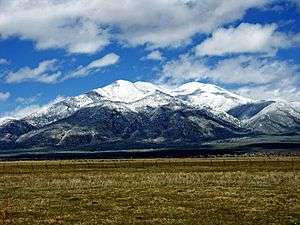
North Central New Mexico generally has a dry, mild continental climate typical of the high desert, although the significant elevation variations in the region produce a lot of unique local conditions. Summer, which lasts from June to August, is the prime tourist season, and sees crowds of visitors clogging the streets of Santa Fe and Taos. While summer temperatures rarely get as brutally hot as in lower and more southern locales, this is still a season marked by high temperatures, with spectacular afternoon thunderstorms common in the monsoonal season of July and August. Spring, which generally lasts from April to early June, sees fewer crowds and lower temperatures, but also very windy, dry weather which makes it the most at-risk time for large wildfires. Autumn, particularly September and October, is arguably the best time to visit; the peak tourist season will be over, the weather tends to be dry and sunny with crisp evenings, there are many local festivals, and the aroma of roasting green chile will be prevalent in many towns. Winter produces the biggest variations in local conditions; towns at lower elevations (Santa Fe, Española, Abiquiu) will see little snow which tends to melt quickly, while locales at higher elevations (Taos, Chama, anywhere in the mountains) are more likely to see snow linger, with snow on the highest peaks sometimes lasting well into spring; the one constant in the winter throughout the region is that temperatures are cold, with pleasantly sunny days giving way to very chilly nights. If you're interested in skiing, winter is the obvious time to visit, and Christmas time in New Mexico is a wonderful cultural experience, although some shops that cater to travelers will be closed (and many businesses will have shorter hours) owing to the general lack of tourists.
Talk
English, of course, but a considerable number of other languages are spoken in the area. Many residents speak Spanish at home and sometimes at school and work, and dialects of Tewa, Tiwa and Keresan are spoken at the American Indian pueblos of the region, and Jicarilla Apache is spoken in the area of Dulce. Visitors for whom English is a second language may have problems with the indigenous version of English, which is often spoken with a rapid, "machine gun" accent, particularly in some of the rural communities where Spanish is dominant. It doesn't take long to get used to the accent, however. Visitors who speak no English or Spanish at all face some challenges, but a surprising number of residents of Los Alamos and, to a lesser extent, Taos and Santa Fe are fluent in the major European and Asian languages.
One recommendation: If you encounter a place name that appears to be Spanish in origin, it's a good idea to pronounce it as Spanish. A majority of place names in this region are Spanish, some of them with diacriticals to prove it (Española, Peñasco, etc.), and persistently avoiding Spanish pronunciations will be interpreted by some residents, many of whom speak Spanish at home, as rude. The pronunciation tips in the Spanish phrasebook are useful here; the most common things to watch for are words with "ñ" as in the Española example, double "l" (e.g. the very common Gallegos surname), and double "r" (e.g. Rio Arriba County, which incidentally is a particularly good place in which to have your Spanish pronunciations in shape).
Get in
The nearest major airport is in Albuquerque. Santa Fe has very limited air service that, so to speak, comes and goes; check the Santa Fe page for current status.
No interstate highways pass through the region, but I-25 skirts it on the southeast as it passes from the Colorado state line on the east side of the Sangre de Cristos, around Santa Fe, and on to Albuquerque. US 84 and US 285 cross north-south through the heart of this region between Santa Fe and Southern Colorado. East-west, US 64 traverses across the northernmost reaches of the area, just south of the Colorado border.
A commuter train, the New Mexico Rail Runner Express, connects the Albuquerque metro area to Santa Fe, with limited service daily. Fares are based on how far you ride, and a day pass will usually be in the range of $5-$10. Tickets can be purchased online or from the conductor on the train. Amtrak's daily Los Angeles-Chicago Southwest Chief route serves North Central New Mexico with a stop in the village of Lamy, about 15 miles south of Santa Fe on US 285, and a shuttle that transports passengers between Lamy and Santa Fe.
Get around
Drive; the area is too big and hilly for there to be viable alternatives. Note that traveler amenities (grocery stores, restaurants, gas stations, etc.) can be few and far between in this region, reliably found only in towns of substance — that is, Española, Los Alamos, Santa Fe, and Taos. Most of the small towns in the region will have at least a gas station and perhaps a diner or two, but given the general lack of options you're not likely to get the best deal on gas or necessities. However, they can be great places to get a taste of the local culture.
This part of the state has severe problems with DUI, so keep your eye out for erratic motorists. Another, possibly related problem is the astounding fraction of vehicles that are seriously decrepit. You probably won't have to log many hours of driving in northern New Mexico before you see something unexpected and hazardous fall off a car or (particularly) truck, maybe in your path. Defensive driving is a good idea, even though the traffic density is low except in and near Santa Fe.
Relying on others for your transportation doesn't work well here. Hitchhiking in this area is an iffy proposition. Traffic density in the rural areas is low, so you may have to wait a long time for a ride, and the DUI issue makes it downright dangerous to be at the roadside at night.
Surprisingly enough for such a rural region, there is a degree of public transit service in the area. The North Central Regional Transit District operates a network of free bus routes on the weekdays that link the communities of the region. However, this service is really meant more as a lifeline for local residents and isn't going to be very convenient for visitors. The only services offered by the NCRTD geared towards visitors are the Taos Express weekend service between Santa Fe, Española, and Taos, and the daily Mountain Trail service between Santa Fe and Ski Santa Fe, both of which charge fares.
See
There are many interesting sights in this photogenic area, most of which are covered in the separate pages for places named in Cities and Other destinations. A few that don't fall conveniently into one of those pages:
Native American life
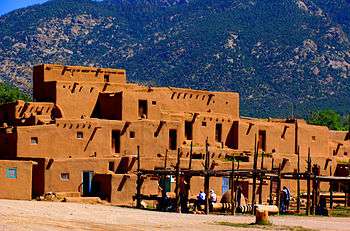
Several American Indian pueblos call the region home, many of which are open to public for visits. Española is a good jumping-off place for visits to most of these pueblos, with a couple easily accessed from Taos. More detailed information on each of the pueblos listed here, as well as those in the central and northwestern regions of the state, can be found in the New Mexico Pueblos guide. In geographic order roughly from north to south, the northern pueblos are:
- Taos Pueblo, on the northern edge of Taos and described further in the guide for the town, is a UNESCO World Heritage Site and probably the most famous of the pueblos, with its iconic ancient village. A small casino sits at the entrance to the reservation.
- Picuris Pueblo sits near the village of Peñasco off NM 75 along the High Road to Taos (see Scenic drives below). This small, relatively isolated pueblo has a fishing lake and some shops selling micaceous clay pottery.
- Ohkay Owingeh Pueblo (formerly the San Juan Pueblo, and still marked as such on some maps) is off NM 68 north of Española along the banks of the Rio Grande, and has a small arts cooperative in the village as well as a large casino along NM 68.
- Santa Clara Pueblo sits just south of Española off NM 30 and is excellent for American Indian arts and crafts. They also operate the Santa Claran Casino in the middle of Española as well as the Puye Cliff Dwellings, an archaeological site that preserves the ruins of an ancient village carved into a cliffside.
- San Ildefonso Pueblo is south of Española, just off NM 502 alongside the Rio Grande, and is another excellent folk art center, noted for being the home of famed potter Maria Martinez.
- Pojoaque Pueblo is near the town of Pojoaque on US 84/285 between Santa Fe and Española, with a gaudy casino and a resort that overshadows an otherwise minor pueblo.
- Nambe Pueblo lies in the foothills of the Sangre de Cristo Mountains southeast of Española and is less tourist-friendly, owing to its location off the beaten path and with few amenities for visitors.
- Tesuque Pueblo is just off US 84/285 north of Santa Fe; this pueblo is also not as tourist-friendly, with the village itself all but off-limits, although there is a flashy casino along the highway across from a little geologic formation known as "Camel Rock," which does indeed look like a camel from certain angles.
Scenic drives
High Road to Taos
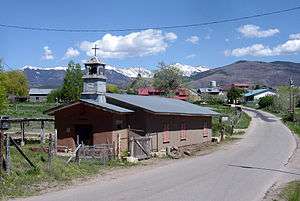
The High Road to Taos, between Taos and Santa Fe, is perhaps the best-known scenic roadway in this area. From south to north, the route is as follows:
- From Santa Fe, follow US Highway 84/285 north through Miocene lake bed formations to Pojoaque and turn east on NM 503. This winding country road leads through the villages of Nambe and Cundiyo to Chimayó, with nice views of the southern Sangre de Cristos as you go. From Española, just head east on NM 76 to Chimayó; this is a nice winding road through a scenic wooded valley past farms. In Chimayó you can visit the locally famous Santuario de Chimayó chapel and local weaving shops.
- Take NM 76 east from Chimayó. This road winds through a number of small, historic farming settlements populated mainly by the Hispanic families who have lived here for generations. Leaving Chimayó, you'll wind past the village of Cordova and climb a steep route to the village of Truchas, perched on a ridge overlooking the Española Valley and with spectacular views of several nearby peaks. After Truchas, the road winds through the mountains, cutting through several small valleys along the way, each with its own village. Las Trampas, one such village, is notable for its large and historic church in the town plaza, right on the main road. Eventually, NM 76 meets NM 75 near Picuris Pueblo; you can turn left and follow the signs about a mile west to the small pueblo, which has a fishing lake and some shops selling micaceous clay pottery. To continue to Taos, turn right on NM 75 instead.
- After passing through the villages of Peñasco and Vadito, NM 75 intersects with NM 518. Turn left and take the winding road through the mountains, where you'll pass through some lovely mountain meadows and past some steep slopes which offer lovely views before eventually emerging out of the mountains at Ranchos de Taos, where you'll find the extraordinarily beautiful San Francisco de Asis Mission Church near the intersection of NM 518 and NM 68. Turn right on NM 68 and continue into Taos, a worthy destination by itself.
- If you're returning to Santa Fe for the night, it's best not to retrace your steps exactly, but rather continue south on NM 68 at its intersection with NM 518 - the "Low Road to Taos" (covered below), descending along the Rio Grande back to Española where you can then get on US 84/285, which you can follow south through Pojoaque to Santa Fe.
Low Road to Taos

The Low Road to Taos, also known as the main route or the river road, is another scenic drive between Santa Fe and Taos, and while it's much faster than the High Road, it also offers some scenic attractions in its own right.
- Starting in Española, take NM 68 north. You'll pass by the Ohkay Owingeh Pueblo (formerly the San Juan Pueblo) on your left, which has an arts cooperative and makes for a pleasant diversion. Continuing along NM 68, you'll pass through the villages of Alcalde and Velarde, both farming towns on the banks of the Rio Grande where there are plenty of roadside fruit stands selling locally grown fruit. There are also a couple of wineries in the area that include tasting rooms open to the public, with some reasonable table wines; none will rival the products of French wine country, but you could do worse.
- After Velarde, the road enters the Rio Grande Gorge and hugs the banks of the Rio for many miles to come. The scenery here is spectacular, with sheer cliffs rising above the road. Along the way, you'll pass by Embudo, most well known for the Embudo Station, an old train station across the river (the tracks are long gone) with a collection of old buildings nearby, such as a lovely old wooden water tower. There's also an on-again, off-again restaurant operating out of Embudo Station. A couple of miles later you'll intersect with NM 75, which passes through the village of Dixon just up the road and makes for a wonderful diversion, with a great number of orchards and vineyards in town as well as several art galleries.
- Continue north along NM 68 to the town of Pilar, the center for whitewater rafting in the region. If you travel this route in the spring or summer, you'll likely see rafts and kayaks making their way down the river before you get to Pilar, and the town itself has a visitor center for the Rio Grande del Norte National Monument, with some camping/picnic facilities along the river nearby. After Pilar, NM 68 climbs out of the gorge with some spectacular views of the gorge northward and the surrounding mountain ranges. NM 68 continues on through Ranchos de Taos on to the destination of Taos.
Enchanted Circle

The "Enchanted Circle" is a circuit that loops around the highest mountains of New Mexico. The whole route takes anywhere from 2.5 hours with no stops to a full day if you make time to explore sights along the route. Heading clockwise from Taos (although this route can be done in either direction from any community along the route):
- Head north from Taos on US 64 to the intersection of US 64 and NM 522. US 64 continues west (left) to the spectacularly high Rio Grande Gorge Bridge several miles west; continue straight on NM 522 towards the village of Questa. Along NM 522 north of Taos, you'll pass by the D. H. Lawrence Ranch, a small shrine that contains the ashes of the late author. From Questa, a very worthy detour is the Wild Rivers Recreation Area, a section of the Rio Grande del Norte National Monument west of town that offers picnicking sites on the rim of the Rio Grande Gorge with spectacular views and some excellent hiking trails down into the gorge. To get there, take NM 522 a couple of miles north from town and turn left on NM 387, a short road that leads directly to the site.
- From Questa, drive east on NM 38 into a canyon through the Sangre de Cristo Mountains to the town of Red River. Along the way you'll pass by a molybdenum mining facility that unfortunately had a disastrous effect on the local ecology; fortunately, clean-up efforts are underway. Red River is an old mining town with many interesting sights and side trips, a winter ski area, offers numerous year round activities, and hosts a large motorcycle rally on Memorial Day weekend.
- From Red River continue east on NM 38 out of the mountains and into the gorgeous Moreno Valley. You'll pass the ghost town of Elizabethtown, many trailheads, and spectacular views of Wheeler Peak, New Mexico's highest point, before reaching Eagle Nest, a small town on the edge of the picturesque Eagle Nest Lake at the base of the valley. In Eagle Nest you'll connect with US 64 again in Eagle Nest; turn right to return to Taos.
- South of the town of Eagle Nest, you'll pass by a turn-off to a state park visitor center for Eagle Nest Lake, where you can get some great info on the area and stop at the lake for fishing. Continue along US 64 to the village of Agua Fria, where you'll pass by the Vietnam Veterans Memorial State Park, one of the first memorials dedicated to veterans of the Vietnam War. In Agua Fria you can turn off on NM 434 for a short detour to the town of Angel Fire, which has a large ski area and a summer resort.
- Continue on US 64 westward to return to Taos; along the way you'll take a winding route back through the Sangre de Cristos. US 64 crosses the crest of the range at Palo Flechado Pass, itself not terribly scenic but with some pretty country nearby.
Jemez Mountain Trail
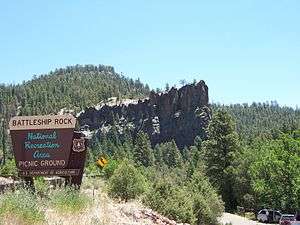
NM State Road 4 follows the Jemez Mountain Trail scenic byway through the Jemez Mountains, another spectacular drive that takes you through some lovely alpine forest scenery.
- From Santa Fe, take US Hwy 84/285 north, exit onto NM 502 at Pojoaque and proceed westward towards Los Alamos. From Española, take NM 30 south until it ends at the intersection with NM 502 and head west towards Los Alamos. There are fine views of the canyon-and-mesa country for about five miles along this road until its intersection with NM 4.
- You can either continue on NM 502 along the edge of a spectacular canyon to Los Alamos (not for the acrophobic!), or take 4 instead, passing White Rock and the turnoff for Bandelier National Monument, which is well worth a visit for its marvelous cliff dwelling ruins. If you choose to head to Los Alamos, you can rejoin NM 4 by taking NM 501 south from Los Alamos; it'll end at NM 4 west of Bandelier National Monument.
- Continuing west on NM 4 will take you on a spectacular, winding road through the Jemez Mountains before emerging at the edge of the Valles Caldera National Preserve, a vast grassland situated in a volcanic caldera. After passing the caldera, NM 4 winds its way through the mountains again, passing several campgrounds, trailheads, and nifty geologic features like Battleship Rock on the way.
- NM 4 continues down the west side of the mountains through the town of Jemez Springs, which has a small developed hot springs as well as a historic site that preserves the striking ruins of a Spanish mission-era church, made of stone from the brilliantly colored red-rock canyon the town sits in. Continuing along NM 4 will take you past more red rock scenery before the road ends at the intersection with US 550 in the village of San Ysidro.
- Unfortunately, from here your shortest route back to Santa Fe is much less scenic: turn left on US 550 to Bernalillo and Interstate 25 and either north to Santa Fe or south to Albuquerque and out of this region.
US Highway 64
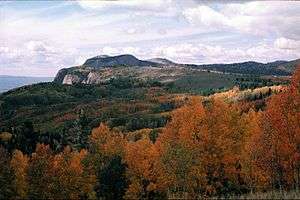
If traveling through the region, rather than within it, US Highway 64 is a scenic option that traverses the region east-west just south of the Colorado border.
- Westbound, US 64 leaves Interstate 25 near Raton in the northeastern region of the state and makes a beeline for the Sangre de Cristos, passing through the towns of Cimarron, Ute Park, Eagle Nest, and past Angel Fire before reaching Taos. Prior to reaching Eagle Nest, you'll pass through Cimarron Canyon, a narrow forested canyon with pleasant views and a state park offering camping and picnic sites along the creek. From Eagle Nest to Taos, you'll be on the southern portion of the "Enchanted Circle" route described above.
- After negotiating the frequently aggravating traffic of downtown Taos, continue north and then west on US 64 across the dizzying heights of the Rio Grande Gorge Bridge. From here, you'll cross a plateau with a spectacular view over Taos and the mountain range beyond. At the tiny settlement of Tres Piedras you'll intersect with US 285; continue straight and into the Carson National Forest.
- The mountains you'll pass through here aren't as high as the Sangre de Cristos but still offer some pleasant alpine scenery. This is a winding road that takes a while to traverse; you'll know you're near the other side when you catch distant views of the startling Brazos Cliffs. From here, the road winds down out of the mountains to the quiet village of Tierra Amarilla on the western edge of the region, where you'll intersect with US 84.
- Turning right on US 64/84 will take you to Chama, with its famed narrow gauge railroad. US 64/84 continues west before slitting apart several miles west of town. From here, you can continue on US 64 into the northwestern region of the state, or follow US 84 into Southwestern Colorado.
Do
.jpg)
This is a tremendous area for the active visitor, particularly if your interests run toward the outdoors. Both the Jemez and Sangre de Cristo mountain ranges offer plenty of opportunities for hiking, mountain biking, backpacking, picnicking, and camping. The Carson National Forest and the Santa Fe National Forest, which administer these areas, both offer excellent information on recreational opportunities in the region. Virtually every town has some good hikes in the vicinity, with some highlights being the foothills above Santa Fe, the canyon-and-mesa country in and around Los Alamos and Bandelier National Monument, the Rio Grande Gorge, and the beautiful red-rock country near Abiquiu.
The Rio Grande Gorge is a well-known destination for river rafting, and the Rio Chama, which flows into the Rio Grande near Española, has one short but spectacular white-water stretch above artificial Abiquiu Lake. There are outfitters in Santa Fe, Taos, and some of the small towns between Taos and Española that run raft trips when conditions are satisfactory (water flow in the rivers varies seasonally, with spring generally being the best time). If you like water sports of a less dramatic nature, there are several small, man-made lakes along the Rio Chama that are suitable for small boating and fishing: Heron Lake and El Vado Lake in the vicinity of Chama, and Abiquiu Lake near Abiquiu.
Birdwatchers can have an interesting time along the Rio Grande, particularly in October and February–March. One of the major North American migratory routes follows the Rio, so that all manner of southbound birds are visible in October and again in late February as they make their way back north. Vast flocks of sandhill cranes and geese fly overhead and can be heard a long distance away. Their wintering grounds are at the Bosque del Apache National Wildlife Refuge, south of Albuquerque in the central part of the state.
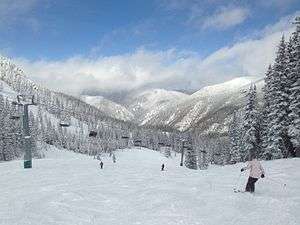
Skiing and snowboarding are popular activities in the winter months, with several developed ski resorts in the region. Ski conditions can vary considerably year-to-year, with some of the resorts relying heavily on artificial snowpack. However, the ski areas in the vicinity of Taos are at generally high enough elevations to ensure decent ski conditions, with Taos Ski Valley being far and away the most famed. Nearby Red River and Angel Fire also have large ski resorts with extensive offerings and facilities. South of Taos along NM 518 is the small ski area of Sipapu, which is less reliable for ski conditions and has fewer offerings, but is rather cozy and much cheaper. Near Los Alamos is the similarly small Pajarito, which is also inexpensive but tends not to open during relatively dry years. Ski Santa Fe above Santa Fe is a major resort at a comfortably high elevation for good snow conditions. Additionally, cross-country skiing is also a possibility in the region after a decent snowfall, with some good trails around Chama and Red River.
At the end of a day out and about, go for a soak in a hot spring. The villages of Ojo Caliente (north of Española on US 285) and Jemez Springs (along NM 4 in the Jemez Mountains) contain "developed" hot springs with tourist facilities (and of course a fee). If you prefer "wild" hot springs, several are along NM 4 through the Jemez Mountains. Warning: dangerously pathogenic amoebas have been isolated from some of the wild springs. Don't let water from the wild springs get into your eyes, ears or nasal passages.
Stay safe
The high mountains pose the usual mountain hazards (altitude sickness and avalanche danger for the hiker/skier, snowpacked roads in the winter for the motorist). Roads here are also plagued by drunk drivers; drive suspiciously, particularly after dark.
There are few significant public-health issues in this region of concern to the traveler, but curiously enough, bubonic plague is endemic, and claims a few victims each year (most recover with prompt and aggressive medical care). Plague is carried by the small animals of the region, so if you see one in distress, leave it alone and let nature take its course; buzzards are immune to plague, you are not. Drinking untreated water from regional streams is not a good idea owing to Giardia parasites, but tap water is generally not a problem.
Small-town bars in this area are not recommended unless you're familiar with the locals. Some have clienteles that don't take kindly to strangers, and in too many of the small towns, a bar is a place to find a fight or worse, not a drink and some relaxation. Santa Fe and Taos have plenty of acceptable bars and the few watering holes in Los Alamos are okay. The casinos associated with the American Indian pueblos also provide nightlife of a sort, if you like that sort of thing.
Go next
See the articles on Central New Mexico, Northeast New Mexico and Northwest New Mexico for the contiguous regions of the state. North of the Colorado state line, South Central Colorado retains much of the flavor of this region, although there is less of the red-rock country that is seen around Abiquiu. The northward extension of the Sangre de Cristos is considerably higher and more rugged than the New Mexico Sangres and provides challenges for the "peak bagger" and technical climber. North of the state line, the high country of the Colorado Plateau bearing Chama and Tierra Amarilla turns into a full-fledged, major mountain range (the San Juans), which serves as the dividing line between South Central and Southwestern Colorado.